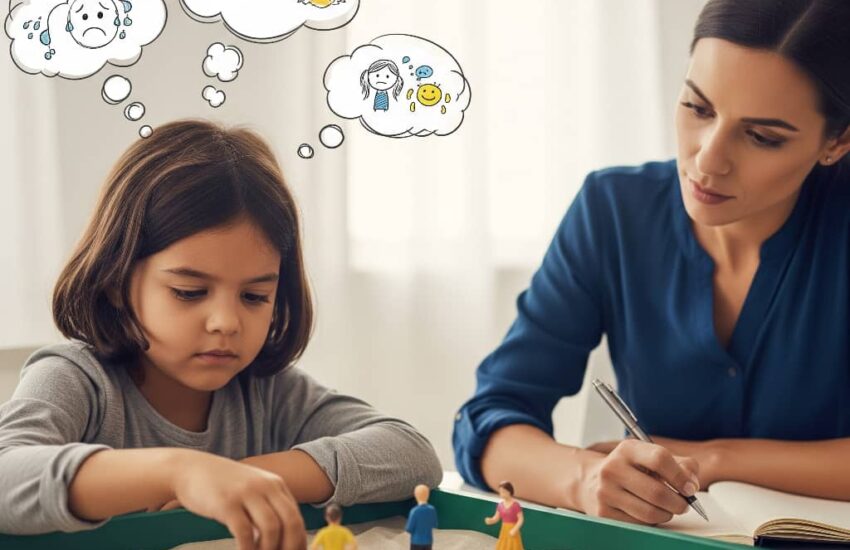Discover how play therapy helps children express emotions, process trauma, and develop coping skills in a safe, supportive environment. Eight-year-old Liam hadn’t spoken since witnessing a violent incident at home. Traditional talk therapy made him withdraw further until his therapist brought out a sand tray and miniature figures. As Liam silently arranged the toys, creating scenes of protection and rescue, his therapist gained insight into his unspoken fears. Within weeks, the sand tray became a bridge to words, then to healing.
This is the power of play therapy. More than just child’s play, it’s a clinically-proven approach that helps children process complex emotions when they lack the vocabulary or emotional capacity to articulate their experiences. Recognized by the American Psychological Association, play therapy gives children a developmentally appropriate language, the language of play to express what words cannot.
How Play Therapy Works
Play therapy operates on a simple but profound principle: play is a child’s natural medium for self-expression. Where adults process experiences through conversation, children work through emotions and events via toys, art, and imaginative scenarios. A trained play therapist creates a safe playroom stocked with carefully selected items—dolls, art supplies, puppets, sand trays—that serve as tools for emotional communication.
During sessions, children lead the play while therapists observe themes, metaphors, and behavioral patterns. A child reenacting car crashes with toy vehicles might be processing anxiety. Another burying “monster” figures in sand could represent overcoming fears. The therapist gently guides the process, helping the child name emotions (“That dinosaur looks really angry”) and model healthy coping strategies through the play narrative.
Research in *Professional Psychology: Research and Practice* shows play therapy reduces behavioral problems by 82% when conducted properly. It’s particularly effective for children aged 3-12 who’ve experienced trauma, grief, divorce, or developmental challenges. Unlike adult therapies that rely on verbal insight, play therapy meets children where they are developmentally, using their innate creativity as a pathway to healing.
The Transformative Benefits for Children

Play therapy’s impact extends far beyond the playroom. Children who participate typically show measurable improvement in three key areas.
Emotional expression becomes more balanced. Reserved children learn to identify and articulate feelings through their play scenarios. Explosive children practice regulating big emotions by acting them out safely pounding clay instead of siblings, or using puppet dialogues to express anger. Therapists often introduce “feeling words” gradually, expanding a child’s emotional vocabulary through play.
Social skills flourish as children rehearse relationships in the safety of pretend play. A child struggling with friendships might practice sharing with toy characters first. Another might use dollhouses to understand family dynamics after a divorce. The playroom becomes a laboratory where children experiment with boundaries, empathy, and conflict resolution without real-world consequences.
Perhaps most importantly, play therapy rebuilds a sense of control. Traumatized children often act out because they feel powerless. In the playroom, they direct the narrative deciding whether the superhero defeats the villain or the baby doll gets “rescued.” This restored agency frequently carries over into daily life, reducing anxiety-driven behaviors at home and school.
Play therapy reminds us that healing doesn’t always require words. By entering a child’s world of imagination and symbol, skilled therapists help transform confusion into clarity, fear into resilience, and isolation into connection. In the hands of a trained professional, simple toys become powerful tools, helping children rewrite their stories one play session at a time. For parents and caregivers, understanding this approach can open new doors when a child’s struggles defy conventional explanations or solutions. The next time you see a child immersed in play, remember: they may be doing far more than passing time, they may be finding their voice.
References
Landreth, G. L. (2021). An overview of play therapy. *International Journal of Play Therapy*, *30*(1), 1-14.
Egan, M. (2022). Play therapy: A review of the evidence base. Be Centre. https://www.becentre.org.au/wp-content/uploads/2023/02/Play-Therapy-A-Review-of-the-Evidence-Base-Myles-Egan-University-of-Newcastle_01.2022.pdf
Ray, D. C., Bratton, S. C., & Rhine, T. (2015). The effectiveness of play therapy: Responding to the meta-analytical reviews. International Journal of Play Therapy, *24*(1), 37-48. https://doi.org/10.1037/a0038605
Bratton, S. C., Ray, D., Rhine, T., & Jones, L. (2005). The efficacy of play therapy with children: A meta-analytic review of treatment outcomes. Professional Psychology: Research and Practice, *36*(4), 376-390. https://doi.org/10.1037/0735-7028.36.4.376

